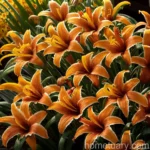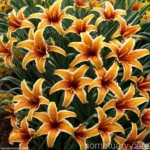Understanding the Daylily (Hemerocallis ‘Ciel D’Or’)
What is a Daylily?
In the world of plants, the daylily (Hemerocallis ‘Ciel D’Or’) holds a special place. With its vibrant and diverse blooms, the daylily is a perennial favorite among both gardeners and horticulturists. This article will delve into the various aspects of this stunning plant – from its cultural needs to its propagation and common diseases, this resource will serve as a comprehensive guide to understanding and caring for the daylily.
Plant Name: Daylily (Hemerocallis ‘Ciel D’Or’)
The daylily, scientifically known as Hemerocallis, is a flowering plant in the genus Hemerocallis. The cultivar ‘Ciel D’Or’ is a specific variety within this genus. Known for its stunning yellow blooms, the Hemerocallis ‘Ciel D’Or’ is a beloved hybrid that has garnered popularity among gardening enthusiasts for its unique characteristics and adaptability.
Key Takeaways – Daylily (Hemerocallis ‘Ciel D’Or’)
Culture
- Medicinal Uses: The daylily has been traditionally used in Chinese medicine for its purported medicinal properties, known to have beneficial effects on health.
- Culinary Uses: Certain varieties of daylilies are also edible and are used in culinary practices, adding a floral and slightly sweet flavor to dishes.
Uses
- Ornamental: Primarily used as an ornamental plant, the daylily’s vibrant blooms add a touch of elegance to gardens and landscapes.
- Wildlife Attraction: Its nectar-rich flowers attract pollinators like bees and butterflies, contributing to biodiversity and ecosystem health.
- Drought Tolerance: Daylilies are known for their resilience and can thrive in dry conditions, making them a popular choice in xeriscaping.
Water
- Water Needs: Daylilies have moderate water needs and are relatively tolerant of drought once established. However, adequate watering is crucial, especially during the blooming season, to support healthy growth and vibrant blooms.
Sunlight
- Sun Exposure: Thriving in full sun to partial shade, daylilies are adaptable to various light conditions, although they tend to bloom best with at least six hours of sunlight per day.
Fertilizer
- Fertilization: Daylilies benefit from a balanced fertilizer application in early spring to support robust growth and prolific blooming. A slow-release or organic fertilizer can be used according to the specific needs of the soil.
Soil
- Soil Preferences: Well-draining soil with a slightly acidic to neutral pH is ideal for daylilies. Amending the soil with organic matter can enhance its fertility and structure, promoting optimal growth and blooming.
Pruning
- Pruning Techniques: Regular deadheading of spent blooms and removal of withered foliage contributes to the plant’s overall health and encourages continuous blooming throughout the season.
Propagation
- Propagation Methods: Daylilies can be propagated through division, seed sowing, or by utilizing cutting propagation methods, offering opportunities for expanding their presence in the garden or sharing with fellow gardening enthusiasts.
Container Popularity
- Container Gardening: The compact size and adaptability of certain daylily varieties make them suitable for container gardening, offering flexibility and versatility in garden design and landscaping.
Common Diseases
- Disease Resistance: While generally resilient, daylilies may be susceptible to certain diseases such as leaf streak and rust. Implementing good cultural practices and maintaining plant health can aid in disease prevention.
Common Pests
- Pest Management: Daylilies may occasionally face pest issues, including aphids and spider mites. Regular monitoring and the use of natural predators or organic pest control methods are effective in managing pest infestations.
Botanist’s Tips
- Landscaping: Daylilies are versatile landscaping plants, complementing various garden styles and designs with their diverse colors and forms. Incorporating daylilies into mixed borders or mass plantings can create visually stunning landscapes.
Fun Facts
- Blossom Duration: Each daylily bloom typically lasts for a single day, giving rise to the plant’s common name. However, the plant produces multiple buds, ensuring continuous flowering over an extended period.
Hemerocallis Ciel D’Or: Characteristics and Cultivation
The Hemerocallis ‘Ciel D’Or’ cultivar is renowned for its distinct characteristics, making it a sought-after addition to gardens and landscapes. Its striking yellow blooms, coupled with its adaptability and reliability, have established ‘Ciel D’Or’ as a perennial favorite among gardening enthusiasts. Let’s explore the specific features and cultivation guidelines for this remarkable daylily variety to gain a deeper understanding of its allure.
Color
The ‘Ciel D’Or’ daylily showcases stunning yellow blossoms, adding a vibrant pop of color to garden beds and borders. The bright and cheerful hue of its flowers enlivens outdoor spaces and pairs beautifully with a wide range of companion plants, enhancing the visual appeal of the landscape.
Appearance
The ‘Ciel D’Or’ daylily presents a captivating appearance with its graceful and elegantly shaped flowers. Its blooms exhibit a classic daylily form, featuring prominent petals and a central throat, complemented by lush, grass-like foliage that further enhances its aesthetic appeal.
Fragrance
While not all daylily varieties are fragrant, ‘Ciel D’Or’ is admired for its subtle, sweet fragrance that adds an olfactory dimension to outdoor spaces. Its delicate scent can contribute to creating a sensory-rich garden environment, inviting visitors to experience the captivating allure of these blooms.
Season
As a summer bloomer, ‘Ciel D’Or’ graces the garden with its radiant blooms during the warm and sunny months. Its vibrant flowers emerge in abundance, offering a spectacular display that brightens outdoor surroundings and captures the essence of the summer season.
Sun Exposure
Thriving in full sun to partial shade, ‘Ciel D’Or’ daylilies adapt well to various light conditions, allowing for versatile placement within the landscape. However, providing ample sunlight promotes robust flowering and ensures the best display of its cheerful blossoms.
Daylily Gardening Tips: Cultivating Hemerocallis ‘Ciel D’Or’
Soil Preferences
- Well-Draining Soil: Ensure that the planting site provides well-draining soil to prevent waterlogging, promoting healthy root development and preventing potential issues associated with waterlogged conditions.
- Soil Amendment: Incorporating organic matter such as compost or aged manure improves soil fertility and structure, enhancing the growing environment for ‘Ciel D’Or’ daylilies.
Watering Practices
- Moderate Watering: Maintain consistent moisture in the soil, providing adequate hydration without overwatering, which can lead to root rot and other related complications. Adjust watering frequency based on environmental conditions and plant needs.
Fertilization
- Balanced Fertilizer: Apply a balanced fertilizer in early spring to support vigorous growth and promote prolific blooming. Consider using a slow-release or organic fertilizer for sustained nourishment.
Pruning and Deadheading
- Regular Maintenance: Engage in regular deadheading of spent blooms and removal of withered foliage to maintain the plant’s appearance and support continuous flowering. Pruning also aids in promoting air circulation and preventing disease.
Pest Management
- Monitoring Pest Activity: Regularly inspect ‘Ciel D’Or’ daylilies for signs of pest infestations, such as aphids and spider mites, taking proactive measures if necessary to manage pest populations and preserve plant health.
Disease Prevention
- Cultural Practices: Implement good cultural practices, including proper spacing, adequate air circulation, and soil drainage, to reduce the risk of diseases such as leaf streak and rust.
Propagation Techniques
- Division: Utilize division as a propagation method to rejuvenate crowded clumps and expand the presence of ‘Ciel D’Or’ daylilies within the garden. Divide plants in early spring or late summer for successful establishment.
Container Gardening
- Container Selection: Choose well-draining containers of appropriate size to accommodate ‘Ciel D’Or’ daylilies. Container-grown daylilies offer flexibility in garden design and can be showcased on patios, balconies, or other outdoor spaces.
Companion Planting
- Complementary Selections: Pair ‘Ciel D’Or’ daylilies with suitable companion plants, such as ornamental grasses, coneflowers, or salvias, to create harmonious and visually appealing plant combinations within the landscape.
Hemerocallis ‘Ciel D’Or’: Disease Resistance and Pests
Disease Resistance
‘Ciel D’Or’ daylilies exhibit moderate resistance to common daylily diseases, although they may occasionally encounter issues that can impact their health and appearance. Understanding disease prevention measures and proactive management techniques is integral to maintaining the plant’s vitality and vigor.
Common Diseases:
- Leaf Streak: Characterized by the appearance of elongated lesions with pale centers on the foliage, leaf streak can affect the overall aesthetic appeal of ‘Ciel D’Or’ daylilies. Implementing proper cultural practices and maintaining plant hygiene are essential in disease prevention.
- Rust: The presence of rust on daylily leaves, indicated by orange pustules and discolored patches, can compromise the plant’s vigor and impact blooming. Promptly addressing rust issues through appropriate fungicidal treatments is crucial to safeguard plant health.
Disease Diagnosis:
- Symptom Recognition: Familiarize yourself with the visual symptoms of common daylily diseases to facilitate early detection and targeted intervention. Regular monitoring and timely action are pivotal in mitigating disease-related complications.
Pest Management
Addressing pest infestations is essential to safeguard the health and vitality of ‘Ciel D’Or’ daylilies, ensuring that the plant can thrive and bloom consistently without the detrimental effects of pest activity.
Common Pests:
- Aphids: These small, sap-sucking insects can infest daylilies, causing stunted growth and distortion of foliage. Employing natural predators and non-toxic pest control measures aids in managing aphid populations effectively.
- Spider Mites: These minuscule arachnids are known for causing stippling and discoloration on daylily leaves, compromising the plant’s overall health. Regular monitoring and strategic intervention assist in preventing widespread damage due to spider mite infestations.
Botanist’s Tips: Cultivating ‘Ciel D’Or’ Daylilies
Landscape Design
- Versatile Planting: Incorporate ‘Ciel D’Or’ daylilies into mixed borders, foundation plantings, or garden beds to introduce a vibrant color palette and textual diversity into the landscape. Their adaptability makes them an ideal choice for various design styles and gardening preferences.
Summer Blooms
- Seasonal Showcase: Capitalize on the radiant blooms of ‘Ciel D’Or’ daylilies during the summer months, using them as focal points within garden designs to infuse outdoor spaces with color and charm.
Sun Exposure
- Optimal Positioning: Select suitable planting locations that provide ample sunlight, promoting robust flowering and ensuring the best display of ‘Ciel D’Or’ daylilies. Adaptable to full sun and partial shade, these versatile plants offer flexibility in garden placement.
Fun Facts about ‘Ciel D’Or’ Daylilies
- Blossom Duration: Each ‘Ciel D’Or’ daylily bloom lasts for a single day, contributing to the plant’s common name and adding an element of fleeting beauty to garden landscapes. Despite the transient nature of individual blooms, the plant produces numerous buds, ensuring an extended period of flowering joy.
External Resources
For further information and insights into daylily cultivation and gardening, refer to the following external resources:
- American Hemerocallis Society – Website
- The Daylily Journal – Publication
- Daylilies: A Fifty-Year Affair – Book
With these valuable resources, you can deepen your knowledge and appreciation of daylilies, enhancing your gardening journey and fostering a deeper connection with these remarkable plants.
In conclusion, the daylily (Hemerocallis ‘Ciel D’Or’) stands as a captivating and versatile addition to gardens and landscapes, offering a myriad of ornamental and practical benefits. Cultivating and caring for ‘Ciel D’Or’ daylilies enriches outdoor spaces, infusing them with vibrant color, fragrance, and visual appeal. By understanding its unique traits and following best cultivation practices, you can elevate your gardening experience and revel in the beauty of these remarkable plants.
[Please note that the information provided in this article serves as a general guide and may vary based on specific environmental conditions and regional factors. To obtain tailored recommendations for daylily cultivation, consult with local horticultural experts and extension services.]
The information provided in this article offers a comprehensive understanding of the daylily (Hemerocallis ‘Ciel D’Or’), covering its cultural aspects, uses, care requirements, and common challenges. By delving into its characteristics, cultivation guidelines, and best gardening practices, this resource equips gardening enthusiasts with valuable insights to nurture and appreciate these remarkable plants. Through the incorporation of external resources, readers are encouraged to further expand their knowledge and explore the diverse facets of daylily gardening.















